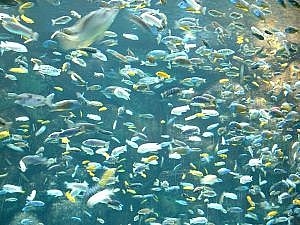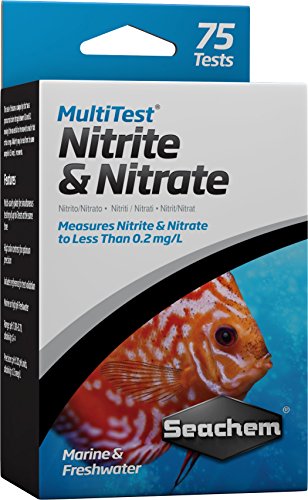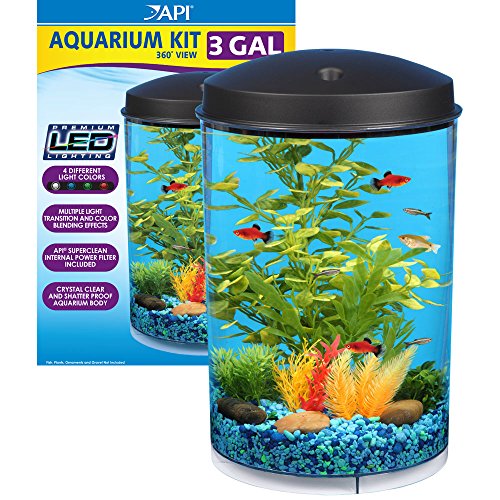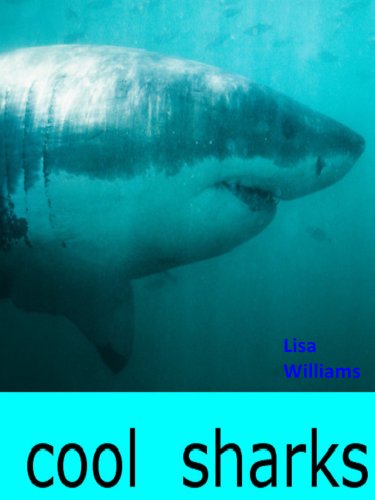
The main purpose of a display tank is to show off your fish and the various elements that go into it-substrate, plants, and decorations-are chosen with that in mind. The purpose of a spawning or rearing tank, on the other hand, is utilitarian, and the decor is meaningful only to the extent that it meets the needs of the fish you're trying to breed or raise in the tank In other words, breeding and rearing tanks don't have to look nice; they just have to get the job done. The following are some of things you will have to take into consideration.
Filtration
Filtration is at least as important-if not more so-in breeding and rearing tanks than it is in other types of setups; it's just a little trickier to deal with. On the one hand, a filter is important for maintaining water quality. On the other, it can interfere with fertilization by drawing in eggs and/or milt. In addition, power filters can agitate the surface of the water, disrupting the spawning process in fishes such as bettas and gouramis since they build bubble nests. The easiest solution is to use a sponge filter in your breeding tanks, and/or shut the filter off during the actual spawning.
Some breeders paint the outside of the bottom of their breeding tanks a dark Color because it seems to make skittish fish feel more secure.
In rearing tanks, all but the gentlest of filters can suck in fry. For that reason, some breeders skip them altogether, relying on water changes to maintain water quality until the fry are strong enough swimmers to avoid the currents created by filters. Alternatively, they use sponge filters set on a very slow bubble.
Substrate
Like just about every other component of a breeding setup, the substrate you choose-if any-depends on the species of fish you're trying to spawn. Pit nesters, for instance, need sand or fine gravel in which to dig their nests, but many other species require no substrate at all.
Substrate can also serve a protective function. Many breeders place a double layer of glass marbles or coarse gravel on the bottom of tanks in which they plan to breed egg scatterers; the eggs drift down into it, out of the reach of the adult fish that might otherwise eat them. They can then hatch in safety. As mentioned, fry tanks typically do not have substrate.
Location
Where you place your tank can sometimes affect your fish's willingness to spawn in it. For instance, skittish fish may be too nervous to breed if their tank is located in a high-traffic area, and fish that are triggered to spawn by morning sun will breed more readily if you position the tank where it will get some natural light. Still others, such as tetras, prefer darker locations, and will be less likely to breed in a tank that gets direct sun.
Lighting
In display tanks, lighting makes it easier to view the fish. In breeding tanks, it serves a more utilitarian purpose, by mimicking the day-night cycles that serve as breeding triggers for some species. Certain African cichlids, for instance, can sometimes be coaxed to breed by adjusting the tank lighting to reflect the longer hours of daylight that occur in the summer. Putting the lights on a timer makes this simple.
Plants and Plant Substitutes
Plants can serve a number of purposes in a breeding tank. They help to maintain water quality by taking in carbon dioxide and giving off oxygen. They can provide spawning sites for plant-choosing egg depositors such as rainbowfish, are incorporated into nests by fish such as dwarf gouramis, and provide hiding places for females that are at risk of being injured by the aggressive behavior of courting males. In addition, thick foliage can provide hiding places for fry in community and species tanks. If the tank will not have substrate in which to root plants, they can be placed in the tank in pots.
It is a good idea to disinfect the plants carefully before placing them into the breeding tank, since they can introduce bacteria and organisms that can harm the eggs. Alternatively, yarn tassels known as spawning mops can be placed in the tank as a substitute for plants. They are easy to make, and can be sterilized by boiling—an advantage over real plants!
Aeration
In display tanks, power filters often provide an aerating function, stirring up the surface of the water and facilitating gas exchange-the process by which atmospheric oxygen enters the water and gases such as carbon dioxide are released. In breeding and rearing tanks, however, the extremely gentle filtration makes the process less efficient, so many breeders compensate by using air pumps and airstones. This is particularly important in tanks where eggs are being incubated, since insufficient oxygen in the water can allow fungus to grow on the eggs.
Spawning Sites
Some fish are downright finicky about where they lay their eggs. Angelfish, for instance, like flat, almost vertical sur¬faces, while many rainbowfish require thickets of vegetation. Some typical spawning sites include plants (real or artificial), rocks, pieces of slate, com¬mercially available spawning cones (conical terracotta structures with a trough at the bottom to catch the eggs), caves, shells (if you're breed¬ing shell-dwelling cichlids), and the substrate itself.
Temperature Control
A reliable heater with a built-in thermostat is essential for breeding tropical fish, since water temperature plays such an important role in both spawning and rearing of the fry. Many professional breeders heat their tank room instead of the water, but this is less practical for small-scale home breeders because of the costs involved. A submersible heater with an easy-to-adjust thermostat is a bonus, since you may have to change the water temperature to trigger spawning in some species.
There are two reasons to provide hiding places in a breeding tank: First, males of many species of fish become quite aggressive toward females during or immediately after spawning, so it's important to provide females with places to escape if things are getting too rough. In addition, some species of fish, such the shell-dwelling cichlids of Lake Tanganyika, will only spawn in enclosed places.
Hiding places don't have to be fancy; they can consist of strategically placed plants or rocks, pieces of PVC pipe set on the bottom or suspended horizontally from the side of the tank with string or wire, terracotta flowerpots placed on their sides or upside down with a hole knocked into the side, hollowed-out coconut halves with "doors" cut into them, and caves made from rock or resin.
There is a wide assortment of other equipment that will often make your experiences with spawning and raising fishes more enjoyable. Be creative and don't be afraid to try new things. You never know, sometimes the smallest adjustment can reap large rewards.
These are nets or plastic cages that are used to separate breeding pairs, pregnant females, and sometimes eggs or fry from the rest of the population in a tank. There are many designs, the earliest of which was a funnel in a jar; the fry could swim through the small hole and escape the mother, who was too large to follow. More modern breeding traps often have perforated grates in the bottom, enabling fertilized eggs to fall through them to safety. Despite the name, the least-practical use of a breeding trap is for spawning, since many fish feel too cramped to breed in its confined quarters. More often, a pregnant livebearer is placed in a breeding trap shortly before delivery, to protect her fry from becoming snacks for other fish in the tank. The drawback is that being in the trap is stressful for the mother-to-be, and can sometimes cause her to lose her fry, especially when she's transferred too early.
These are similar to the grates in some breeding traps, except that they are placed in the bottom of the tank itself. The fertilized eggs drift through the holes in the grate, hatching beneath it in safety, out of reach of adult fish that might eat them. Although they are sometimes available commercially, many breeders make their own from "egg crating" (plastic grids used to protect fluorescent ceiling lights, available in home-supply stores) or the perforated plastic mesh used for needlework.
 How to Take Care of The Baby Betta Fish
How to Take Care of The Baby Betta Fish
How to Take Care of The Baby Betta Fish
How to Take Care of The Baby Betta Fish
 How to Feed an Oscar Fish
How to Feed an Oscar Fish
How to Feed
How to Feed an Oscar Fish
How to Feed an Oscar Fish
How to Feed
 How to Reduce Nitrates in Fish Tank
You can always can find some nitrates in a typ
How to Reduce Nitrates in Fish Tank
You can always can find some nitrates in a typ
 How to Not Kill your Fighting Fish
A little over a year ago, my
How to Not Kill your Fighting Fish
A little over a year ago, my
 Why are there so Many More Shark Attacks?
In 2004 16 year old, J.P And
Why are there so Many More Shark Attacks?
In 2004 16 year old, J.P And
Copyright © 2005-2016 Pet Information All Rights Reserved
Contact us: www162date@outlook.com